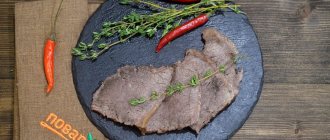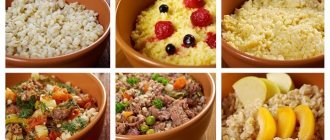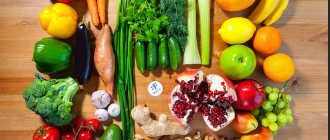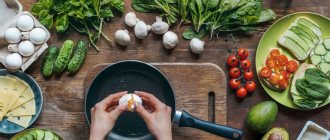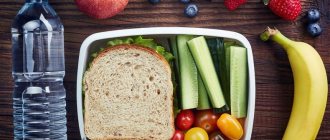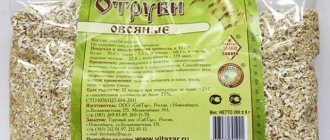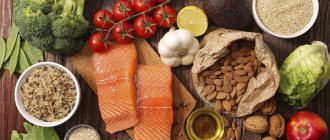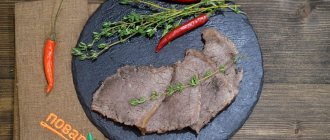When losing weight, a person’s diet should be rearranged in accordance with the recommendations of nutritionists and doctor’s prescriptions. However, often people interested in losing weight or a healthy lifestyle create their own menu, making a number of serious mistakes. In most cases, there is an incorrect approach to including protein foods in the diet. To get rid of unnecessary difficulties, it is enough to study what dietary meat is, what types there are, its properties and basic methods of preparation.
What meat is considered dietary?
Dietary meat should be understood as a product that contains a minimum amount of fat and large amounts of nutrients necessary to maintain the functioning of the body and normalize health.
Using this component, diets, treatment tables and other nutritional regimens are created aimed at losing weight and restoring the human body during or after serious illnesses. Dietary meat is also common among athletes who need meat protein to form muscle mass.
Additional recommendations
When is the best time to eat?
At any main meal. It is better to eat veal and beef for lunch, chicken and turkey for dinner. Considering the long digestion of meat in the stomach, you should not eat it at night. This will contribute to the storage of fat, slow down weight loss and can cause intestinal disorders.
What's the best way to cook?
- Choose the leanest part (in poultry, for example, this is the breast).
- Rinse.
- Remove the skin and subcutaneous layers of fat.
- Boil in unsalted water - this is an ideal cooking option for weight loss.
- Baked, steamed and stewed are also allowed.
What is compatible with?
- Leafy greens: lettuce, spinach, sorrel, parsley, cilantro, dill, basil;
- vegetables: avocado, white and cauliflower, green peppers, cucumbers, celery.
Is it possible to give it up completely?
If you decide to combine giving up meat and losing weight, you will have to carefully work on what to replace it with so that the body does not feel a deficiency of the essential nutrients of which it is a source:
- nuts, legumes and grains are plant sources of protein;
- eggs and dairy products are animal sources of protein, vitamins A and E;
- sprouted wheat, bran, buckwheat, corn contain B12;
- vegetables, fruits, nuts, herbs, cereals are rich in iron;
- replacing meat with fish will compensate for the deficiency of phosphorus, protein, vitamins A and E;
- dark green, red and yellow vegetables and fruits saturate the body with vitamins A and E;
- Some nuts (Brazil, pine, almonds) and seeds (sesame) contain a lot of phosphorus.
The only vitamin that is not found in any other food product is D, but to prevent its deficiency, frequent sun exposure is sufficient. In addition, vitamins and microelements, the main source of which is meat, can be replenished with dietary supplements, multivitamin complexes, and individual medications if you refuse it.
What kind of dietary meat: types
Not every product meets the characteristics that are required to include an ingredient in the diet of a person trying to lose weight. The most dietary meat is rabbit or chicken. However, nutritionists allow the use of other types of products, with which you can diversify the menu and achieve the desired results. Therefore, it is worth examining each option separately.
Rabbit meat as the leader in the list of dietary meats
Dietary rabbit meat is a leader in this category due to its defining characteristics:
- calorie content – 180 kilocalories per 100 grams of product;
- amount of proteins – 21 grams;
- amount of fat – 11 grams;
- is absorbed by the human body by 90%;
- almost complete absence of sodium salts;
- helps speed up metabolism.
The most dietary meat is also characterized by hypoallergenicity. This property allows the use of rabbit meat in the menu of young children, the elderly, pregnant women and allergy sufferers.
Chicken meat is the most common option
The main competitor of rabbit meat due to the following indicators:
- calorie content – 170 kilocalories per 100 grams;
- proteins – 20 grams;
- fats – 9 grams;
- strengthens the immune system.
Important: these positions largely depend on the quality of the product, as well as on the part of the carcass consumed. So, people who are losing weight will have to exclude the skin from their diet. Despite the significant taste sensations, it is characterized by the presence of the most harmful components.
In addition to dietary characteristics, the defining positive point over rabbit meat is the availability of chicken. Still, not every store can find a rabbit.
Turkey - an alternative to chicken
Turkey is valued primarily for its beneficial substances, which practically do not lose their properties after cooking. The defining indicators are:
- calorie content – 200 kilocalories;
- protein – 21 grams;
- fats – 12 grams;
- absorbed by the body by 95%;
- minimum cholesterol (without skin).
Another important property is that it is prescribed by doctors for the prevention of cancer. The availability is somewhat lower than chicken, but in terms of taste it is in many ways superior to its closest competitor.
Can I have a duck?
It is problematic to classify the meat of such poultry into the category of dietary products due to its not very effective characteristics:
- calorie content is high - 290 kilocalories;
- high fat – 24 grams;
- less protein - 17 grams.
And yet the product contains a lot of vitamins and minerals that can bring considerable benefits to the body.
With the right approach to using fat, you can take advantage of its beneficial properties. Dietary duck meat is characterized by the following characteristics:
- normalizes potency;
- cleanses the human body of carcinogens;
- provides regulation of metabolic processes.
Excessive fat can be reduced by removing the skin and surface fat.
Should you include veal in your diet?
If we consider veal as dietary meat, then it can be called one of the best options:
- calorie content - only 100 kilocalories;
- protein – 19 grams;
- fats are kept to a minimum – about 2 grams.
Despite the impressive characteristics, in practice not everything is so simple. Excessive consumption can cause health problems due to insufficient muscle tissue development in livestock. In addition, it promotes the development of malignant neoplasms in individuals predisposed to cancer.
Nutritionists and doctors have come to a consensus on this matter - it is not recommended to eat veal more than once a week.
Is beef a dietary meat?
This product is valued not only for its taste, but also for its beneficial properties, which have a positive effect on human health and help in losing excess weight. This dietary meat is primarily included in the protein menu. The choice of nutritionists is determined by the characteristics of the product:
- calorie content – 125 kilocalories;
- proteins – 20 grams;
- fats – 3 grams;
- helps normalize the degree of stomach acidity;
- rich in mineral and vitamin complexes.
The key disadvantage is that cooking beef is not very easy - to do this you will have to have at least a minimum of culinary skills.
Is pork always prohibited?
Dietary meats usually do not include pork due to its excessive fat content. It is unlikely that you will be able to lose weight if you have such a product in your diet. However, not everything is so simple - individual parts of the carcass differ from each other in a number of defining indicators. For example, the upper part of the fillet is characterized by the following properties:
- calorie content – 125 kilocalories;
- proteins – 22 grams;
- fats – 4 grams.
Therefore, pork lovers who want to lose weight can breathe easy - meat can be included in the diet.
Dietary dishes made from lamb meat - is it possible?
As in the case of pork, when adding lamb to the diet menu, you will have to be content with only certain parts of the carcass. However, with proper selection, you can use it in your usual diet without excessive restrictions. The properties are:
- calorie content – 165 kilocalories;
- proteins – 20 grams;
- fats – 10 grams;
- regulates cholesterol levels;
- normalizes metabolism.
Lamb is useful for anemic conditions, as it contains large amounts of magnesium, iodine and potassium.
Pork
Pork is often criticized for its fat content and is therefore considered not a very healthy meat. However, it has sufficient beneficial properties. It contains almost all B vitamins in very large quantities, which are not typical for meat. Pork is digested somewhat less well than other types of meat, but it contains a lot of nutrients and minerals.
In large quantities, pork can be harmful to the body, it can even disrupt metabolism and lead to obesity. Pork is also dangerous because it contains dangerous parasites, so pork must always be cooked very thoroughly.
How to properly build a menu with dietary meat dishes?
Even when choosing dietary meat, it is important not to forget to take into account that this product is difficult for the body to digest. Therefore, you need to take into account not only the type, but also the timing of meals and additional components. So, you should adhere to a number of simple rules:
- It is better to schedule dietary meals with meat for lunch. If it is not possible to set up consumption during the daytime, then it can be postponed until a later time. But strictly - until 6 pm. The body needs a lot of time to digest meat, so dinner should be light: vegetables, fruits, low-fat kefir - this option should be preferred;
- It is not recommended to combine dietary meat and foods with a high content of starches or large amounts of grains in recipes, which also require more than one hour until they are digested. When they are combined, the stomach will be additionally loaded, which will ensure a feeling of heaviness;
- The best option is to eat it with raw vegetables, which contain a lot of fiber and elements to speed up the digestion process. This will allow you to quickly cope with digestion, relieving the person of the feeling of heaviness and hunger;
- maximum consumption volume – 500 grams;
- if there is a need to replace a dietary product, you can use seafood, fish or eggs;
- If a person wants to lose weight faster, in addition to creating the right menu, he needs to not forget about physical activity.
Important: despite the fact that the type of product can be determined depending on a person’s preferences, it is still recommended to include poultry meat in the diet. With this choice there are fewer restrictions and negative consequences from excessive use.
Prohibited or undesirable varieties
There are also varieties that are best avoided for weight loss because of their fat content and high calorie content:
- pork;
- mutton;
- duck;
- goose.
Pork
Calorie content: 259 kcal.
Harm:
- causes allergies;
- increases the risk of cardiovascular diseases;
- contains a lot of cholesterol;
- is considered “dirty” meat, since many impurities are found in it (toxins, the same hormones, antibiotics);
- poorly absorbed, complicates digestion.
Mutton
Calorie content: 209 kcal.
Harm:
- difficult to digest, clogs the intestines, impairs digestion;
- disrupts the functioning of the liver and gall bladder;
- promotes the development of arthritis.
Duck
Calorie content: 250 kcal.
Harm:
- helps increase cholesterol levels;
- hard fibers are difficult to digest and clog the gastrointestinal tract;
- contraindicated for obesity, diabetes, problems with the thyroid gland, digestion, and liver;
- may cause allergies.
Goose
Calorie content: 412 kcal.
Harm:
- disrupts the functioning of the stomach;
- slows down metabolism;
- may cause helminthiasis;
- Contraindicated for obesity, atherosclerosis, diabetes mellitus and pancreatic pathologies.
It is also not recommended to consume meat products when losing weight: sausages, frankfurters, ham, bacon, lard, etc. All of them are high in calories, high in fat, and also (most often) in the presence of harmful food additives (flavor enhancers, flavorings, preservatives ).
How to cook better: recipes for dietary meat dishes
Meat is one of the main sources of protein, which ensures the functioning of the body and satisfies the feeling of hunger. To minimize cholesterol in food, proper cooking methods must be used. People who want to lose weight are recommended to boil, bake or steam meat. At the same time, you should limit the addition of salt and seasonings to food.
Why do you need to bake and how to do it?
Baked dishes are characterized by the preservation of not only useful properties and characteristics, but also the appearance of aroma and natural taste. Another advantage of this method of cooking is that dietary meat, after heat treatment in the oven, comes out very juicy. You can bake either simply on a baking sheet or using a special sleeve or foil.
What are the features of steam cooking?
This method is most suitable for those who seek to completely eliminate even hints of harmful components from their menu. Steaming is prescribed by doctors for people with serious health problems, including stomach problems. To achieve a pleasant taste, you can add mushrooms, cheese or vegetables. For cooking, you can use special equipment in the form of a double boiler or multicooker. If they are absent - over a regular saucepan with bubbling water.
How to boil?
If a person has decided to become an adherent of a healthy lifestyle, then this method of cooking will help achieve variety in the menu, as it allows you to prepare food with many options. So, if the diet rules do not prohibit the consumption of meat with vegetables, then you can cook soup from these ingredients. The only clarification for this case: the meat will have to be boiled separately, and the vegetables will need to be stewed.
Boiled beef with leeks and apple mustard
Boiled beef with leeks and apple mustard
Cooking time: 1 hour + 2 hours 30 minutes
What you need (4 servings):
- medium leek stalk - 1 pc.
- medium carrots – 1 pc.
- medium onion – 1 pc.
- parsley sprigs and root – 2 pcs.
- beef for main courses from Samson – 500 g
- unrefined olive or sunflower oil
- sea salt
For mustard:
- medium sour apples, Antonovka is better in season – 2 pcs.
- mustard seeds - 4 tbsp. l.
- black peppercorns – 2 pcs.
- cloves – 2 buds
- small piece of cinnamon stick
- brown sugar - 1 tbsp. l.
- sea salt
- lemon juice – 3 tbsp. l.
How to cook:
Step 1: Prepare apple mustard. Place the apples in a small saucepan, pour in 2-3 tbsp. l. water and place over medium heat, bring to a boil and cook covered for 10 minutes. Let cool, then carefully scrape out the flesh, removing the core, and return to the saucepan.
Step 2. Crush mustard seeds, black pepper, cloves, cinnamon, sugar and salt in a mortar, pour into a saucepan with apples, pour in lemon juice. Bring to a boil over low heat, stirring, and cook for 1 minute. and remove from heat. Transfer to an airtight jar, cool for 30 minutes, and refrigerate for at least 1 hour.
Step 3. Cut the leek stalk in half lengthwise and rinse thoroughly to remove sand. Cut off the green part. Peel the carrots, parsley root and onions and bake in a dry, heated frying pan, turning often, for 7 minutes.
Step 4: Place the beef in a saucepan with some boiling water and bring to a boil. Skim the foam from the broth, add the roasted vegetables, parsley sprigs and the green part of the leek. Cover with a lid and cook until the meat is soft, about 1 hour. Remove the meat from the broth, cover with foil, and keep in a warm place.
Step 5. Strain the broth and bring to a boil. Cut the white part of the leek into thin half rings, add to the broth, bring to a boil, and simmer over low heat for 5 minutes. Then remove with a slotted spoon and drizzle with oil.
Step 6. Cut the meat into portions and serve with leeks and apple mustard.
Contraindications
A protein diet is not suitable for everyone; there are several significant contraindications:
- pregnancy;
- feeding;
- kidney and liver diseases;
- chronic gastrointestinal diseases;
- cardiovascular pathologies;
- protein intolerance;
- diabetes;
- increased levels of cholesterol, uric acid;
- adolescence and after 40 years;
- lactose intolerance;
- depression;
- prostration;
- bad feeling;
- avitaminosis;
- low immunity.
It is contraindicated to follow a strict diet for more than 10 days. You cannot continue the course if side effects occur.
Permitted and prohibited products
Daily calorie intake is 1200 units. With increased physical activity, the indicator is increased by 300 kcal. The menu is compiled taking into account permitted and prohibited products.
What to eat:
- lean meat;
- fish;
- eggs;
- seafood;
- liver;
- heart;
- language;
- fermented milk products;
- oatmeal, buckwheat, rice;
- vegetables (potatoes in limited quantities);
- unsweetened fruits;
- vegetable oil;
- unsweetened drinks, still mineral water.
What is prohibited:
- semi-finished products;
- fast foods;
- canned food;
- sausages, sausages;
- confectionery;
- baked goods;
- sweet fruits;
- pasta;
- coffee, tea, cocoa;
- alcohol;
- carbonated drinks;
- chocolate;
- margarine;
- fried foods.
Your daily diet should contain healthy fats and carbohydrates, but the main share comes from protein products.
Advantages and disadvantages
Each diet program has advantages and disadvantages. As for the meat diet for weight loss, if it lasts 7-10 days, there are no undesirable consequences. However, before starting the course, you should take into account the individual characteristics of the body and the presence of chronic diseases.
Pros:
- there is no feeling of hunger, there are no breakdowns;
- the result lasts for a long time provided you follow the correct diet;
- there is no psychological discomfort, since almost everyone likes meat;
- suitable for people with an active lifestyle and heavy physical activity;
- a wide range of permitted dishes, a lot of things can be prepared from meat.
Minuses:
- load on the kidneys;
- due to the lack of fiber, indigestion occurs and diarrhea occurs;
- the condition of nails and hair worsens;
- unbalanced diet;
- weakness;
- decreased tone;
- fast fatiguability;
- increased blood clotting, changes in blood pressure, risk of blood clots;
- production of uric acid, exacerbation of gout;
- load on the heart;
- the appearance of bloating, increased gas formation, and stool disturbances.
Side effects occur when eating too much meat, ignoring contraindications, or violating the timing of the diet.
Doctor's opinion
Specialists support a healthy diet, an active lifestyle, and the absence of bad habits. Regarding the meat diet, you can find different statements, but most of them are negative.
Angelina Volk, gastroenterologist, Moscow
“For the normal functioning of the body, proteins, carbohydrates, and fats are required. Of course, we are talking only about useful components. When the idyll is disrupted, metabolic processes fail and adipose tissue begins to appear. With a sharp exclusion of fats and carbohydrates from the diet, theoretically they should be consumed from already deposited fats, but this is not always the case. A repeated disruption of the usual metabolism is perceived by the body as a dangerous situation, and it again begins to stock up for a “rainy day.”
Instead of easing the burden on the digestive organs, a high-protein diet puts stress on them. Meat is difficult to digest, the stomach, pancreas, liver, duodenum, gall bladder, and kidneys suffer. Under such pressure, the whole body begins to malfunction, which cannot but affect well-being and health. Excessive consumption of protein is dangerous to health, so a meat diet is not the best option!”
Ostrich
Meat is very exotic for our country, however, it is becoming a commodity among Russian chefs and sellers, and ostrich farms are becoming more and more popular. Ostrich meat has a very low calorie content (114 Kcal per 100 g) and low fat content, while the protein content is quite high - 22%. Ostrich meat also contains manganese, phosphorus and potassium.
Ostrich meat is red in color and tastes similar to veal, but is particularly tender. Chefs all over the world value ostrich meat for its sensitivity: the meat is easily imbued with the aromas of vegetables and spices during cooking.
You might be interested in: Why does an ostrich hide its head in the sand →
Reviews and weight loss results
Dear readers, was this article helpful? What do you think about the effectiveness of meat in losing weight? Leave feedback in the comments! Your opinion is important to us!
Irina
“I was on a strict diet. I ate exclusively chicken, turkey, and vegetables. I drank kefir. Lasted 5 days. I lost 1.5 kg of excess weight, but after that I couldn’t look at meat for a long time, I was disgusted.”
Olga
“I was on a meat diet for a week. Towards the end I began to feel dizzy and weak. I drank sweet tea with honey and felt better. You can't live without carbohydrates! I lost 2 kg, but now I realized that there is no better diet than healthy eating. There is also meat there, but they eat it without fanaticism and in moderation.”
Post Views: 1,328
